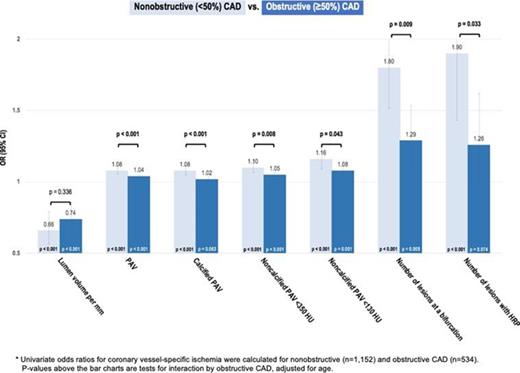-
PDF
- Split View
-
Views
-
Cite
Cite
U Gianni, I.J Van Den Hoogen, A.R Van Rosendael, A.M Bax, S.W Tantawy, H.J Chang, P Genereux, G Pontone, D.S Berman, J Narula, P Knaapen, F.Y Lin, J.K Min, J.J Bax, L.J Shaw, CREDENCE Investigators , Effect of plaque characteristics on ischemia by invasive fractional flow reserve in nonobstructive versus obstructive coronary artery disease: results from the CREDENCE trial, European Heart Journal, Volume 41, Issue Supplement_2, November 2020, ehaa946.1373, https://doi.org/10.1093/ehjci/ehaa946.1373
Close - Share Icon Share
Abstract
Mismatches between the severity of coronary stenosis and the presence of ischemia by invasive fractional flow reserve (FFR) are frequently reported.
To investigate whether plaque characteristics as evaluated with coronary computed tomography angiography (CCTA) may explain this discordance in nonobstructive versus obstructive coronary artery disease (CAD).
From the CREDENCE trial, 612 patients with suspected CAD at 13 sites (64±10 years, 70% men) underwent CCTA with semi-automated whole heart quantification and invasive coronary angiography with 3-vessel FFR measurements. Obstructive CAD was visually defined as ≥50% stenosis. The primary endpoint of coronary vessel-specific ischemia was defined as FFR ≤0.80. Generalized estimating equations were calculated to evaluate the effect of plaque characteristics on coronary vessel-specific ischemia. Interactions were tested by obstructive CAD, adjusted for age.
Among 1,686 vessels, ischemia was present in 436 (26%) vessels. In both nonobstructive and obstructive CAD, the majority of plaque characteristics were associated with coronary vessel-specific ischemia (p≤0.005, Figure 1). In nonobstructive CAD, odds for ischemia were significantly higher for total percent atheroma volume (PAV, p<0.001), calcified PAV (p<0.001), noncalcified PAV <350 and <130 HU (p≤0.043), the number of lesions at a bifurcation (p=0.009) and the number of lesions with high-risk plaque (HRP, p=0.033) when compared with obstructive CAD.
Our findings reveal that ischemia by FFR is documented in the setting of both nonobstructive and obstructive CAD on CCTA. Detection of atherosclerotic plaque characteristics associated with ischemia can potentially improve diagnostic certainty and guide management of symptomatic patients with nonobstructive CAD.

Figure 1. Odds ratios for ischemia.
Type of funding source: Public grant(s) – National budget only. Main funding source(s): National Institutes of Health - National Heart, Lung, and Blood Institute



